Ireland, Wales, and England
Daily Itinerary
Explore Ireland, where in ancient times pilgrims traversed the country in search of sacred shrines and tranquility. In our time, Ireland is known for its castles, legendary mounds and mystical stone monuments. The Emerald Isle holds much for the modern traveler to explore. A land renowned for its many holy, healing places, where Druids once taught and Celtic culture thrived; Ireland is also the repository of Christian Mysticism.
We cross the Irish Sea to Wales, a country of ageless myths and legends, stretching back into the mists of time. The lands are scattered with memorials in stone from over 5,000 years ago, the times of the great Neolithic Builders. Some of the best preserved Ancient sites in the World can be found throughout Wales. These beautiful hills and valleys are an ancient and historical gold mine.
Our journey ends as we experience the perfect mix of the magical and mystical in a land now known as Great Britain which anchors a vortex of great power and elemental force. It is a land full of enchantment and magic, the home of the Mother Goddess, and called by the Celts the "Blessed Isles of the West". Merlin, King Arthur, Avalon, Goddesses, Druids, and the standing stones... all of these are synonymous with the sacred lands of England. They are mystical, magical ancient places where legends lived and their history and stories are still encoded into the land.
Day 1
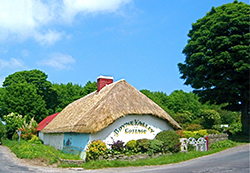 Travel to the town of Drogheda, near the Boyne Valley, the sacred land of the Tuatha de Danann, the people of the Goddess Danu, and one of the great ancient tribes of Ireland. They were an ancient pre-historic, legendary people, famous for their knowledge of medicine, healing, and the mystical arts. Check into your hotel. Mandatory orientation late afternoon followed by a group welcome dinner.
Travel to the town of Drogheda, near the Boyne Valley, the sacred land of the Tuatha de Danann, the people of the Goddess Danu, and one of the great ancient tribes of Ireland. They were an ancient pre-historic, legendary people, famous for their knowledge of medicine, healing, and the mystical arts. Check into your hotel. Mandatory orientation late afternoon followed by a group welcome dinner.
Day 2
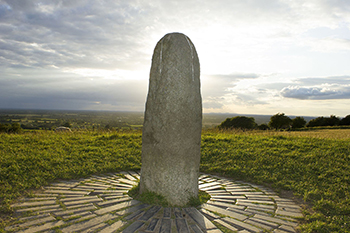 Today visit the Hill of Tara, home of ancient Irish royalty in Celtic, pre-Christian times. According to tradition, it was the seat of Árd Rí na hÉireann, or the High King of Ireland. The coronation stone called The Lia Fail or Stone of Destiny has rested here down the ages. Walk over the remains of the castle on the Hill of Tara and experience the special energy still present here. This site has been famous for its intrinsically strong "earth" energies for over 4000 years. In ancient Irish religion and mythology, Tara was revered as a dwelling of the gods and an entrance place to the otherworld of eternal joy and plenty where no mortal ever grew old. In the legends of St Patrick’s mission to Ireland he is said to have first come to Tara to confront the ancient religion in its most powerful sight. See the remains of huge circular earthworks that were used mainly for rituals in prehistoric times. There are energy lines that connect this site to other sacred sites nearby.
Today visit the Hill of Tara, home of ancient Irish royalty in Celtic, pre-Christian times. According to tradition, it was the seat of Árd Rí na hÉireann, or the High King of Ireland. The coronation stone called The Lia Fail or Stone of Destiny has rested here down the ages. Walk over the remains of the castle on the Hill of Tara and experience the special energy still present here. This site has been famous for its intrinsically strong "earth" energies for over 4000 years. In ancient Irish religion and mythology, Tara was revered as a dwelling of the gods and an entrance place to the otherworld of eternal joy and plenty where no mortal ever grew old. In the legends of St Patrick’s mission to Ireland he is said to have first come to Tara to confront the ancient religion in its most powerful sight. See the remains of huge circular earthworks that were used mainly for rituals in prehistoric times. There are energy lines that connect this site to other sacred sites nearby.
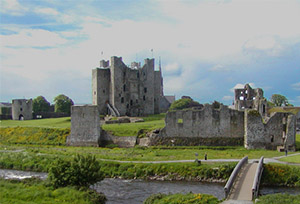 Then visit the medieval city of Trim, the best remaining example of the Middle Ages and containing more medieval buildings than any other town in Ireland. Over the centuries, Trim Castle was adapted to suit the needs of its owners and the changing political climate, however, much of the fabric of the castle remains to this day. Return to your hotel in Drogheda. Dinner included.
Then visit the medieval city of Trim, the best remaining example of the Middle Ages and containing more medieval buildings than any other town in Ireland. Over the centuries, Trim Castle was adapted to suit the needs of its owners and the changing political climate, however, much of the fabric of the castle remains to this day. Return to your hotel in Drogheda. Dinner included.
Day 3
Today experience Bru na Boinne, one of the largest and most important prehistoric megalithic sites in Europe. It is an extensive complex, dominated by three large passage tombs, Newgrange, Knowth and Dowth – which were declared a world heritage site by UNESCO in 1993. It is estimated that there are 700 decorated stones at Bru na Boinne making it Europe’s largest and most important concentration of megalithic art. The most famous of these stones is the one marking the entrance to Newgrange where the triple spiral, unique to this site, can be seen.
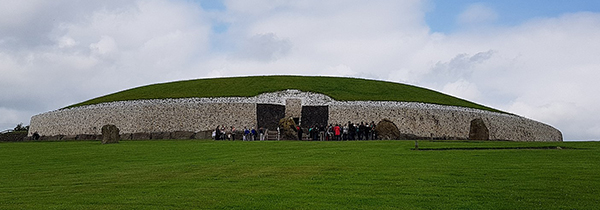
The tombs at Newgrange are more than 5000 years old, 1000 years older than Stonehenge and 500 years older than the Pyramids in Egypt.
Although the people who built these tombs were primarily farmers, they also possessed expertise in engineering, geology, art and astronomy.
Newgrange is best known for the illumination of its passage and chamber by the winter solstice sun. At dawn on the morning of the winter solstice and for a few days before and after, the main chamber at Newgrange is illuminated by a beam of sunlight for 17 minutes. This alignment is too precise to have occurred by chance. It is thought that Newgrange is the oldest surviving deliberately aligned structure in the world. Return to your hotel in Drogheda. Dinner included.
Day 4
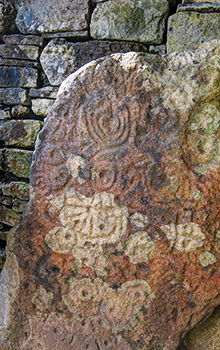 Today we travel to Loughcrew, an immense ceremonial site with beautiful pre-Celtic ritual designs, plus other ancient sites. The Loughcrew complex is a megalithic cemetery containing around 30 passage tombs; a distinguishing feature of Irish passage tombs is the presence of rock art – carved or picked designs on the internal or external stones of the tombs. Certain symbols seem to have been favored at particular tombs or cemeteries: spirals at Newgrange, concentric rectangles at Knowth and rayed circles at Loughcrew.
Today we travel to Loughcrew, an immense ceremonial site with beautiful pre-Celtic ritual designs, plus other ancient sites. The Loughcrew complex is a megalithic cemetery containing around 30 passage tombs; a distinguishing feature of Irish passage tombs is the presence of rock art – carved or picked designs on the internal or external stones of the tombs. Certain symbols seem to have been favored at particular tombs or cemeteries: spirals at Newgrange, concentric rectangles at Knowth and rayed circles at Loughcrew.
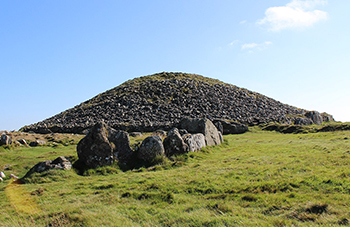 One of the best preserved and most accessible tombs at Loughcrew, known as Cairn T, is thought to be the central tomb of the entire complex. It faces the rising sun at the vernal and autumnal equinoxes which shine through the passage chamber to illuminate symbols carved on to the back wall of the chamber. This tomb is reputed to be the resting place of Ollamh Fodhla, a legendary King of Ireland. Return to your hotel in Drogheda with dinner included.
One of the best preserved and most accessible tombs at Loughcrew, known as Cairn T, is thought to be the central tomb of the entire complex. It faces the rising sun at the vernal and autumnal equinoxes which shine through the passage chamber to illuminate symbols carved on to the back wall of the chamber. This tomb is reputed to be the resting place of Ollamh Fodhla, a legendary King of Ireland. Return to your hotel in Drogheda with dinner included.
Day 5
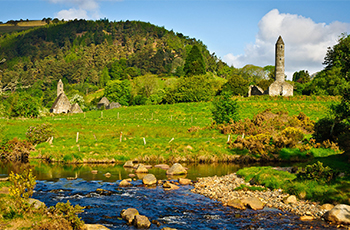 Today we travel south to Glendalough, from the Irish “Gleann da locha", meaning the Glen of two Lakes. It combines extensive monastic ruins at St. Kevin’s Monastery with a stunning natural setting in the Wicklow Mountains. The beauty and tranquility of the lakes offers a presence of peace. St. Kevin's dates back to the early days of Christianity. Founded in the sixth century, it is among the most important historical sites in Ireland. It was the most famous and powerful monastery throughout Europe and the number one place for learning. Legend holds that St. Kevin was one of Merlin the Magician’s teachers, and that the monastery at one time housed the Holy Grail. See the markings in the shape of the Grail at the entrance, and the immense, famous St. Kevin's cross. This massive slab of granite carved around 1150 A.D. is the Celtic form of a cross superimposed on a wheel representing the four directions and the cosmos.
Today we travel south to Glendalough, from the Irish “Gleann da locha", meaning the Glen of two Lakes. It combines extensive monastic ruins at St. Kevin’s Monastery with a stunning natural setting in the Wicklow Mountains. The beauty and tranquility of the lakes offers a presence of peace. St. Kevin's dates back to the early days of Christianity. Founded in the sixth century, it is among the most important historical sites in Ireland. It was the most famous and powerful monastery throughout Europe and the number one place for learning. Legend holds that St. Kevin was one of Merlin the Magician’s teachers, and that the monastery at one time housed the Holy Grail. See the markings in the shape of the Grail at the entrance, and the immense, famous St. Kevin's cross. This massive slab of granite carved around 1150 A.D. is the Celtic form of a cross superimposed on a wheel representing the four directions and the cosmos.
Then travel to Carlow with a stop at Browne’s Hill Dolmen. This Portal Tomb has the largest capstone of any megalithic monument in Ireland. It weighs over 100 tons, measures 20 square feet and is believed to be part of an even larger boulder. The megalith can actually be seen from the road and does not look that impressive, but as you approach the dolmen the enormity of this structure will take your breath away. This megalithic structure belongs to the late stone age, around 2500 BC. We continue on to Wexford, a charming village, where we will overnight before we travel to Wales.
Day 6
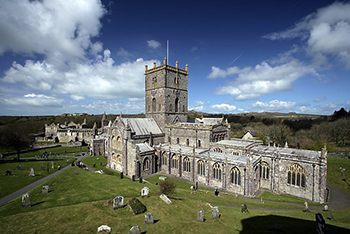 Ferry from Rosslare, Ireland to Pembroke, Wales where we will spend the next three nights. Check in to your five star luxury hotel in St. David’s. Afternoon/evening free to explore this quaint town, the U.K.’s smallest city, including St. David’s Cathedral.
Ferry from Rosslare, Ireland to Pembroke, Wales where we will spend the next three nights. Check in to your five star luxury hotel in St. David’s. Afternoon/evening free to explore this quaint town, the U.K.’s smallest city, including St. David’s Cathedral.
Day 7
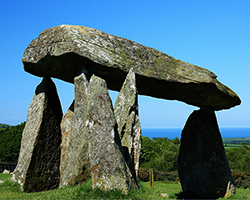 Today travel to the quaint village of Fishguard and from there to Pentre Ifan, the most popular megalithic site in Wales, a burial chamber with a huge capstone delicately poised on three uprights. This monument dates back to about 3500 BC and is unusually oriented north-south. Local lore says that sometimes fairies are seen here. Later visit Carrig Samson Burial Grounds, a 5,000 year old Neolithic burial chamber, situated high on a cliff overlooking Abercastle Harbour and the Irish Sea. The name Carreg Samson arises from a local legend that the Celtic Saint Samson created the monument by flicking stones from the island in Abercastle Harbour with his little finger.
Today travel to the quaint village of Fishguard and from there to Pentre Ifan, the most popular megalithic site in Wales, a burial chamber with a huge capstone delicately poised on three uprights. This monument dates back to about 3500 BC and is unusually oriented north-south. Local lore says that sometimes fairies are seen here. Later visit Carrig Samson Burial Grounds, a 5,000 year old Neolithic burial chamber, situated high on a cliff overlooking Abercastle Harbour and the Irish Sea. The name Carreg Samson arises from a local legend that the Celtic Saint Samson created the monument by flicking stones from the island in Abercastle Harbour with his little finger.
Day 8
 Today, travel to Carn Ingli, a key bronze age settlement site with dwelling huts, abundant stone takes, clearance cairns, trackways, entrenched tracks, standing stones, stone walls, ring cairns, paddocks and burial cairns; we will visit the Preseli Hills in Pembrokeshire National Coast Park where many prehistoric sites exist. Feel the energy at the stone circle of Gors Fawr, a circle of some 70 feet in diameter with nearby two larger stones aligned on a NW-SW axis. The circle is near the supposed site where the "bluestones" of Stonehenge were quarried.
Today, travel to Carn Ingli, a key bronze age settlement site with dwelling huts, abundant stone takes, clearance cairns, trackways, entrenched tracks, standing stones, stone walls, ring cairns, paddocks and burial cairns; we will visit the Preseli Hills in Pembrokeshire National Coast Park where many prehistoric sites exist. Feel the energy at the stone circle of Gors Fawr, a circle of some 70 feet in diameter with nearby two larger stones aligned on a NW-SW axis. The circle is near the supposed site where the "bluestones" of Stonehenge were quarried.
Day 9
Today continue on to Glastonbury in England; check into your charming hotel.
Day 10
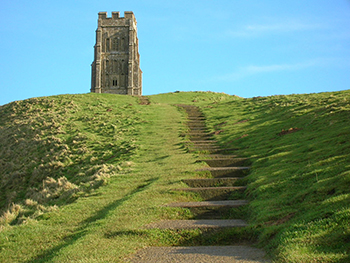 Today visit the “Tor”, recognized as a holy hill for millennia. You will develop a personal and profound relationship with this ‘not so ordinary’ hill. There are many myths and legends associated with the Tor – it is the home of Gwyn ap Nudd, the Lord of the Underworld and King of the Fairies, and a place where the fairy folk live. It is not only the underground world of the Tor which holds a mystery. Upon the surface of the Tor there are seven levels of terracing, some easy to see and some lost in part by erosion. These are the present remains of a great three-dimensional maze based upon the same pattern as the ancient Kretan Labyrinth of the Goddess. This pattern appears on coins from Crete, one of the major civilizations of the Goddess in the ancient world, on rocks at Tintagel and is found among the Hopi Indians as a symbol for Mother Earth.
Today visit the “Tor”, recognized as a holy hill for millennia. You will develop a personal and profound relationship with this ‘not so ordinary’ hill. There are many myths and legends associated with the Tor – it is the home of Gwyn ap Nudd, the Lord of the Underworld and King of the Fairies, and a place where the fairy folk live. It is not only the underground world of the Tor which holds a mystery. Upon the surface of the Tor there are seven levels of terracing, some easy to see and some lost in part by erosion. These are the present remains of a great three-dimensional maze based upon the same pattern as the ancient Kretan Labyrinth of the Goddess. This pattern appears on coins from Crete, one of the major civilizations of the Goddess in the ancient world, on rocks at Tintagel and is found among the Hopi Indians as a symbol for Mother Earth.
The maze is a single pathway which winds back and forth seven times around the steep slopes of the Tor to the center. The path must be retraced on the way out. As a sacred rite of passage, it is a ritual maze and needs to be walked with awareness and reverence.
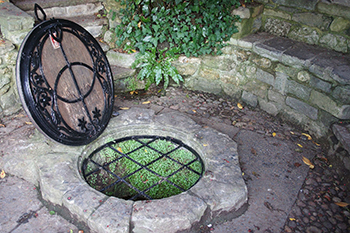 Next visit Chalice Well, considered a natural goddess site that according to some legends, was the hiding place for the Holy Grail. Many legends are attributed to its chalybeate waters, which flow ceaselessly at a steady rate and temperature that never varies. Not least among these is that they represent the blood of Christ miraculously springing forth from the ground when Joseph of Arimathea buried or washed the cup used at the Last Supper. For others the waters are acknowledged as the essence of life, the gift from Mother Earth to sustain its living forms and so a continuous spring like Chalice Well is a direct expression of an unbounded life force. Find solace, peace and inspiration here. The male and female leylines intertwine from the Chalice Well garden up the Tor in a symbolically fertile embrace of masculine and feminine energy.
Next visit Chalice Well, considered a natural goddess site that according to some legends, was the hiding place for the Holy Grail. Many legends are attributed to its chalybeate waters, which flow ceaselessly at a steady rate and temperature that never varies. Not least among these is that they represent the blood of Christ miraculously springing forth from the ground when Joseph of Arimathea buried or washed the cup used at the Last Supper. For others the waters are acknowledged as the essence of life, the gift from Mother Earth to sustain its living forms and so a continuous spring like Chalice Well is a direct expression of an unbounded life force. Find solace, peace and inspiration here. The male and female leylines intertwine from the Chalice Well garden up the Tor in a symbolically fertile embrace of masculine and feminine energy.
Visit White Spring, a calcium and energy rich well that flows up at the foot of the Tor. Rich in minerals it is interestingly devoid of iron, and has a sparkling clear white hue. The White Spring waters flow upward from underneath the sacred chalk earth of the Tor and carry sacred water of a masculine vibration and it’s relationship to the Chalice Well is undeniable.
Day 11
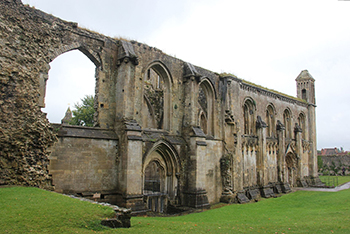 Today we visit the ruins of the famous Glastonbury Abbey which exhibits the evidence of mystical Christianity in the sacred geometry of its design. Glastonbury Abbey, the birthplace of Christianity in England and referred to as the ‘holiest earth in England’, was once the largest and most powerful abbey in all of Britain. It is no coincidence that the dual energy currents of England’s most famous leyline cross at the site of the high altar. A grave in the center of the Abbey ruins is reputed to have been the resting place of King Arthur and Guinevere.
Today we visit the ruins of the famous Glastonbury Abbey which exhibits the evidence of mystical Christianity in the sacred geometry of its design. Glastonbury Abbey, the birthplace of Christianity in England and referred to as the ‘holiest earth in England’, was once the largest and most powerful abbey in all of Britain. It is no coincidence that the dual energy currents of England’s most famous leyline cross at the site of the high altar. A grave in the center of the Abbey ruins is reputed to have been the resting place of King Arthur and Guinevere.
Day 12
Today we travel approximately an hour to Salisbury and check in to our local hotel. This afternoon we have arranged with local farmers to visit 2014 crop circle formations during this peak time when these extraordinary phenomena occur. 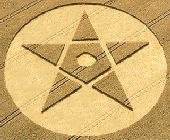 As we walk through the fields and step into the Crop Circles, you will experience the thrilling vortex of energy that created them; whoever or whatever created them, they are striking. The energy is said to be particularly strong in new crop circles. Wiltshire is well known for its mysterious crop circles and much mystery still remains as to why they occur and the meanings behind their complex formations. Crop circles in Wiltshire often occur around the heart of the county in and around Stonehenge and Avebury with dozens of geometric symbols, mandalas and beautiful patterns appearing in the farmers growing crop fields each and every year.
As we walk through the fields and step into the Crop Circles, you will experience the thrilling vortex of energy that created them; whoever or whatever created them, they are striking. The energy is said to be particularly strong in new crop circles. Wiltshire is well known for its mysterious crop circles and much mystery still remains as to why they occur and the meanings behind their complex formations. Crop circles in Wiltshire often occur around the heart of the county in and around Stonehenge and Avebury with dozens of geometric symbols, mandalas and beautiful patterns appearing in the farmers growing crop fields each and every year.
Day 13
 Experience Avebury and Silbury Hill. We start with Avebury, the heart centre of megalithic Britain. Here, within the largest stone circle in the world, find the remains of two former stone circles, one solar and one lunar. All the sacred sites in this area centre on Avebury, including Stonehenge some twenty miles away. Powerful earth energy currents course through this landscape and this may well be one of the reasons why the majority of crop circles occur within a 10 mile radius of Avebury.
Experience Avebury and Silbury Hill. We start with Avebury, the heart centre of megalithic Britain. Here, within the largest stone circle in the world, find the remains of two former stone circles, one solar and one lunar. All the sacred sites in this area centre on Avebury, including Stonehenge some twenty miles away. Powerful earth energy currents course through this landscape and this may well be one of the reasons why the majority of crop circles occur within a 10 mile radius of Avebury.
Avebury is on the edge of an area called the Warminster Triangle. Strange sounds, celestial lights, crop circles, electromagnetic effects, ghosts, black dogs, folklore, energy lines, ancient sites, UFO landings, humanoids, invisible walkers, geophysical strata are all a legendary part of this powerful site.
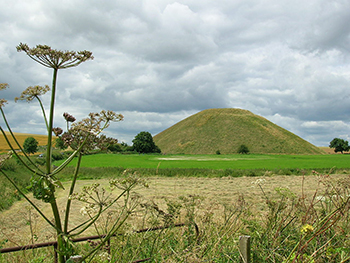 Also see nearby Silbury Hill, an immense human-made hill or mound, the largest of its kind in the world, on which construction was started also about 4,500 years ago. These sites are on ley lines or an energy grid that connects them to other major sites in the British Isles.
Also see nearby Silbury Hill, an immense human-made hill or mound, the largest of its kind in the world, on which construction was started also about 4,500 years ago. These sites are on ley lines or an energy grid that connects them to other major sites in the British Isles.
Day 14
Visit Stonehenge, one of the wonders of the world. By government permission, you will have a special private sunrise visit inside the Inner Circle of Stonehenge. Stonehenge, an ancient ceremonial site located on the Salisbury Plain, is said by some legends to have been built under the magical direction of Merlin. Called the Giant's Ring, it suggests a circular dance.

Archeologists date the building of the different stages of Stonehenge between 3600 and 2100 B.C. Astronomers agree it could be a celestial observatory and others believe it has mystical healing powers.
 Before returning to our hotel, visit the White Horse of Uffington; with its elegant lines of white chalk bedrock, it is thought to be the oldest hill figure in Britain. The image is a stylized representation of a horse (some would say dragon) some 374 feet in length, and is thought to date back as far as 1000BC in the late Bronze Age. Farewell dinner and celebration.
Before returning to our hotel, visit the White Horse of Uffington; with its elegant lines of white chalk bedrock, it is thought to be the oldest hill figure in Britain. The image is a stylized representation of a horse (some would say dragon) some 374 feet in length, and is thought to date back as far as 1000BC in the late Bronze Age. Farewell dinner and celebration.
Day 15
Check out and departure.
Note: Itinerary subject to change.